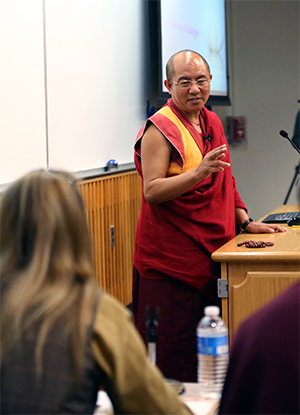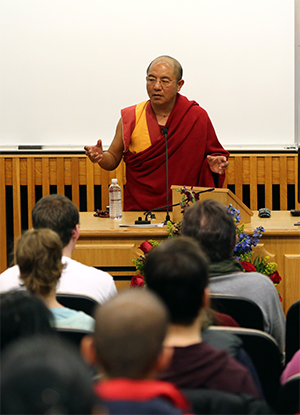Buddhist Meditation on Emptiness
It’s not just about meditation; it’s not just about the wisdom of emptiness. This talk tells you the combination of these two in a very Tibetan Buddhist way. If you listen carefully enough, you will discover some treasured secrets of Vajrayana practice, which Khenpo referred to as “the most precious teachings I’ve ever received.”
How It Appears, If It Is Empty?
Excerpt 1: Why Does the Mind Not Exist?
In his Fundamental Wisdom of the Middle Way, Nagarjuna analyzes the essence of mind—if the mind exists inherently, there’s no need for it to arise; if inherently it doesn’t exist, it can never arise.
Excerpt 2: Can You Find Your Mind?
Where does the mind arise? Whether you check inside or outside of your body, you cannot find it. When the conceptual thought arises, does it exist in your head, in your heart, or in your mouth? When it ceases, does it fly to the sky or disappear within the body? By examining where it comes from, remains and goes, you will realize that the mind has no intrinsic existence. As The Diamond Sutra says, past thoughts are intangible, present thoughts are intangible, and future thoughts are intangible.
Excerpt 3: To Realize Emptiness, Follow a Teacher
If you want to learn driving, you need a coach. Likewise, if you want to understand Buddhist teachings, especially the truth of emptiness that is free from all elaboration, you need to follow a guru. The realization of emptiness through practicing the pith instructions given by the guru is the unsurpassable achievement in your life.
Excerpt 4: Stabilize Your Mind, See What Will You Know!
When we look up at the sky, the sky is empty. Likewise, when we discern our mind, although many kinds of thoughts arise, they are empty. For instance, when we feel angry, our mind at that instance is empty, like the sky, not impeded by anything. Stabilize your mind, discern it, then you will know.
Excerpt 5: How It Appears, If It Is Empty?
Although the mind has no intrinsic existence, its nature is clarity. So we can see whatever we see and hear whatever we hear. The Samadhiraja Sutra says, “The reflection of the moon appears on the surface of a still clear lake, and yet the reflection has no intrinsic existence—such is the nature of all things.” This exemplifies the union of appearance and emptiness. It is the ultimate reality of everything.

To Realize Emptiness, Follow a Teacher
If you want to learn driving, you need a coach. Likewise, if you want to understand Buddhist teachings, especially the truth of emptiness that is free from all elaboration, you need to follow a guru. The realization of emptiness through practicing the pith instructions given by the guru is the unsurpassable achievement in your life.

How It Appears, If It Is Empty?
Although the mind has no intrinsic existence, its nature is clarity. So we can see whatever we see and hear whatever we hear. The Samadhiraja Sutra says, “The reflection of the moon appears on the surface of a still clear lake, and yet the reflection has no intrinsic existence—such is the nature of all things.” This exemplifies the union of appearance and emptiness. It is the ultimate reality of everything.
“No matter whether you believe in Buddhism or not, it is important for you to know the nature of your mind. The myriads of sufferings experienced by human beings are rooted in the ignorance of this nature. The two methods to realize the nature of mind are analytical meditation and stabilizing meditation.”
